Last Updated on: February 5, 2025
Maryland is known to be a home for animals whether they may swim, walk, or fly.
So,,,
It’s really no surprise that you’re here right now wanting to know more about these beautiful birds in Maryland.
Let’s talk about this state’s bountiful bodies of water, natural scenes, and most importantly, birds you want to see up close once you book a flight to Little America.
The 12 Maryland Birds Plus Pictures, Fun Facts, And So Much More!
1. House Sparrow (Passer domesticus)
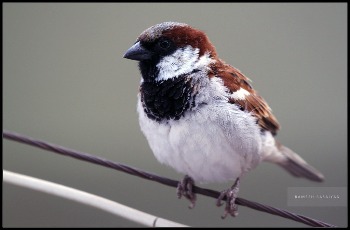
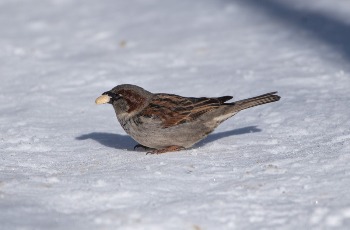
House Sparrows were once native to Eurasia but were introduced to much of the rest of the world in the year 1851.
These birds are widespread and abundant in cities, neighborhoods, and farms. Luckily, to spot these birds, you won’t have to get into dense forests as they seem to not like places like that.
The males (first image) have black bibs, bright rufous napes, stunningly patterned wings with buffs and dark brown streaks, and pale pearly-gray underparts. Females (second image) are plain brown with small round faces and light-shaded foreheads.
Behavior
These backyard birds may often be found foraging for food while hopping on the ground. They can also be spotted perching on stalks and tree barks.
You may see flocks of House Sparrows cluster in dense bushes, bustling around and chattering to one another.
Diet
House sparrows have the tendency of eating almost any food that is around; this behavior is similar to those of Mourning Doves.
Although they may have their preferences like seeds (especially black oil sunflower seeds) and insects, they would also munch on weeds, grass, waste grain, and even food scrubs left by humans.
Fun Fact
One of the most interesting behaviors of the House Sparrow species is that they throw soil and dust over their bodies; these are called dust baths.
2. Eastern Bluebird (Sialia sialis)

The Eastern Bluebird species are beautiful birds that share the same color palettes with a peacock’s coverts.
They have brilliant royal blue faces and bellies that are topped with a rusty warm red-brown bib that goes all the way to their eyes. Their backs are pale emerald green, and their wings and tails have blue tinges.
Behavior
These birds may be spotted on telephone wires, nest boxes, and even furiously chasing insects to the ground during the summertime.
They forage for food by hovering above the ground to catch seeds, insects, and berries. They prefer to flutter around than perch on trees or land on the ground.
Diet
The diet of Eastern Bluebirds mainly consists of both insects and berries. They prefer berries during winter, but in other seasons they love to snack on arthropods, worms, snails, and so much more.
Fun Fact
The average lifespan for Eastern Bluebirds is 6 years. However, in 1989, there was one bird that lived for 10 years and 6 months!
3. House Finch (Haemorhous mexicanus)
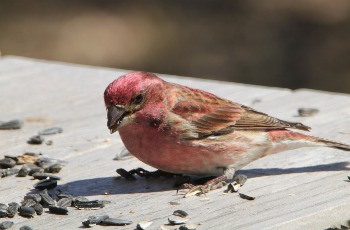
House Finches are backyard birds that were recently introduced from the West to the East part of North America.
These birds are covered in a pale shiny red plumage and white underparts. Their winds have brown bars that serve as their marks from the Finch species. They have thick conical beaks and long tails.
Behavior
These backyard birds love to perch; you may see them in trees, shrubs, and weeds, looking for seeds. The only time you’ll see them un-perched is when they nest or forage in flocks.
Diet
The majority of House Finches’ diet is seeds, so filling your feeder with black oil sunflower seeds is a smart move.
They also take an interest in buds, flower parts, berries, small fruits, and sugar water.
Fun Fact
The red pigment of a House Finch’s plumage comes from the food that they eat. Other birds don’t have the ability to make bright red or bright yellow colors, but the more pigmented the food house finches eat, the redder their plumage gets.
4. Carolina Wren (Thryothorus ludovicianus)
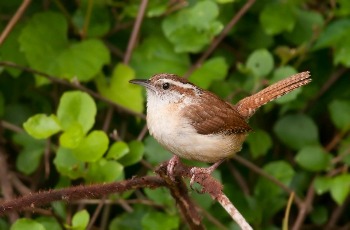
Carolina wrens reside in eastern and southeast USA.
Their round and plump bodies are covered with dirty white underparts and chestnut brown upperparts. Their eyes are rounded and accompanied by white long eyebrows that reach up to their napes.
Behavior
Carolina Wrens are often spotted in wooded or vegetative areas.
These birds love wood, so they often spend their time exploring barks, trunks, branches, and foliages as they forage with other birds.
Diet
These birds feed on many kinds of insects, whether it may be caterpillars, beetles, tree frogs, millipedes, or spiders, you name it!
During the wintertime, they take an interest in berries, tiny fruits, and seeds from time to time.
Fun Fact
The birds in Maryland are surely skilled in vocalization as one captive Carolina Wren once sang nearly 3,000 times within 24 hours.
5. Brown-Headed Cowbird (Molothrus ater)
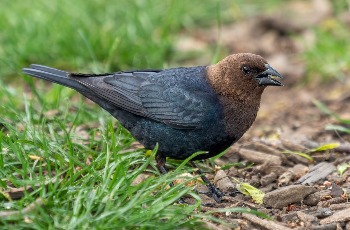
The Brown-headed Cowbird species is known for its abundant production of eggs; they sometimes lay more than three dozen a season.
These big and plump backyard birds have shiny deep brown plumage that is cut by a deep blue and emerald green from their chest all the way to their tails. They have thick beaks and long legs that are both deep black in color.
Behavior
The “Cowbird” in their names come from their strange behavior of associating with cattle and horses.
They are also found grazing through the grass as they forage for insects and arthropods.
Diet
Seeds make up half of a Brown-headed Cowbird’s diet during the summer. They still eat insects just like most common backyard birds do, but not as much.
Fun Fact
The Brown-headed Cowbird species are known as Northern America’s “brood parasite.” Despite the many eggs they lay, they do not build nests but lays them on the nests of other birds instead.
6. White-Breasted Nuthatch (Sitta carolinensis)
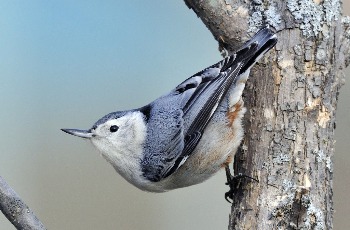
White-breasted Nuthatches are known to be a favorite feeder bird of many due to their lively acrobatic abilities and fearlessness.
Although it is only a little bird, it is still America’s largest nuthatch.
Larger than Dark-eyed Junco’s, these birds have a round head, barely any neck, and a very short tail. They have long legs and bills. Their plumages are a combination of their black napes, grayish-blue caps, dirty white faces, and a pattern of black and pale blue on their back.
Behavior
White-breasted Nuthatches love trunks and large parts of trees; they spend most of their time climbing and exploring a tree’s surface. Even when foraging for food, these birds stay at the branches and bark of trees.
Diet
During summertime, these birds shy away from seeds, but during winter, it takes over more than half of their diet.
Suet, peanut-butter mixtures, and common seeds are what they look for in bird feeders.
The young are known to only eat tiny insects but adult birds do too from time to time.
Fun Fact
In the state of Colorado, there was once a White-breasted Nuthatch that lived for 9 years and 9 months in the year 1971.
7. Carolina Chickadee (Poecile carolinensis)
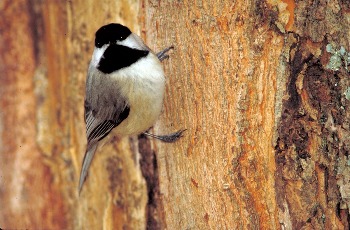
Out of all of the birds in Maryland, Carolina Chickadees are the only species that were introduced by a famous biologist: Charles Darwin.
The iconic deep black hourglass shape on their faces is what makes these birds easy to identify. Their cheeks and underparts are grayish-white and their wings and back are covered in both black and dark gray. Their feet, beaks, and eyes are very tiny.
Behavior
These birds are interestingly found hanging upside down as they reach the nits and picks of tree branches and twigs.
They also have the habit of storing their food in hard-to-reach areas and retrieving them in the latter part of the day.
Diet
These Chickadees consume more vegetable matter like seeds, berries, and tiny fruits than they consume insects. However, during warm months, they snack on caterpillars and almost nothing else.
It is easy to attract these birds with tubes, cages, and platform feeders. You can fill these up with suet and both black oil and sunflower seeds.
Fun Fact
When a Carolina Chickadee and a Black-Capped Chickadee come in contact, they have the urge to hybridize or sing the songs of each other simultaneously.
8. Downy Woodpecker (Dryobates pubescens)
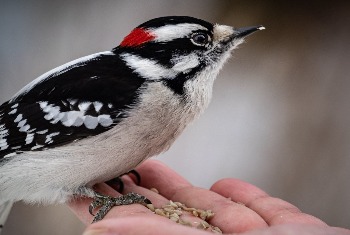

Downy woodpeckers live in the forests and woodlands along rivers city parks and backyards, it’s where the insects and worms commonly are.
These birds look almost exactly alike with their black and white wing patterns (black feathers with white tips). Their underparts are fully light gray and their heads have a black and white stripe.
The only thing that differentiates their sexualities is that the male (first image) has a red spot on their napes while the females (second image) do not.
Behavior
Downy Woodpeckers are small birds that often feed in the backyards and blend with other birds like chickadees or nuthatches.
They have an aerobic build that lets them climb and hang upside down as they forage on trunks, major limbs of trees, branches, twigs, shrubs, and stalks.
Male and female woodpeckers show great differences in their ways of searching for food.
Diet
The Downy Woodpecker species eat mostly insects, their favorites are beetles, ants, and caterpillars.
You may attract these birds by filling your bird feeders with seeds, berries, and suet. They also take interest in bird baths and bird houses, just make sure to position them near bushes or trees.
Fun Fact
These wild birds do not have the ability to sing songs, instead, they drum loudly against pieces of wood in order to achieve the same sound. How amazing!
9. Northern Cardinal (Cardinalis cardinalis)
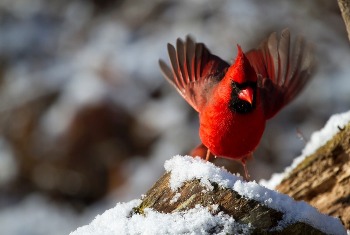
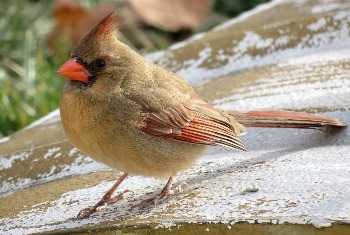
The Northern Cardinals are native to the eastern part of America, while some live in the states of South America and extend westward to Arizona.
Male (first image) Northern Cardinals are purely striking bright red with black around their face and on the tips of their wings. On the other hand, females (second image) have some dazzling brown colors instead of bright red. Both genders have red beaks, tails, feet, and crests.
These birds are very territorial and are ready to attack anything and anyone that comes near.
Behavior
Forages mostly while hopping on the ground or in low bushes, sometimes higher in trees. Readily comes to bird feeders, where it favors sunflower seeds.
Diet
A Northern Cardinal’s diet mainly consists of seeds, insects, and berries. But when it comes to variation, these birds won’t settle for a couple of types, they eat numerous kinds of seeds, insects, and berries.
Their young are only fed insects just like White-breasted Nuthatches.
Fun Fact
Whether it may be due to their rare plumage or interesting behavior, these Cardinals are certainly a crowd favorite as they are the state bird of seven states.
10. Song Sparrow (Melospiza melodia)
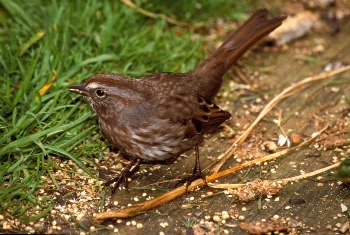
Song sparrows may not be as striking as other backyard birds, but they often make their most distinctive songs to attract partners during springs and summers with a relatively constant sound.
They are about the size of white-throated sparrows and reside in North America during winter but migrate to the south for breeding.
The Song Sparrow species are mainly brown. If there is any other color present in their bodies, it is tiny spots of white on their eyebrow and below their bellies. They have short conical beaks and long tails and feet.
Behavior
These common backyard birds can be seen scratching the soil trying to turn up random items during their spare time.
They mostly forage for food on the ground but they also love shallow bodies of water and shrubs too.
Diet
The diet of a Song Sparrow is mainly insects and seeds.
During summertime, they eat a huge amount of various insects. But in winter, they feed heavily on seeds from grasses and weeds, which means filling up your bird feeders with sunflower seeds will surely attract them.
Tiny fishes are also part of their diet which is a very rare behavior of a sparrow.
Fun Fact
Song Sparrows are best at building nests. They choose only the best spots from their young making sure it is durable, long-lasting, safe, and big enough for a dozen.
11. Red-bellied Woodpecker (Melanerpes carolinus)
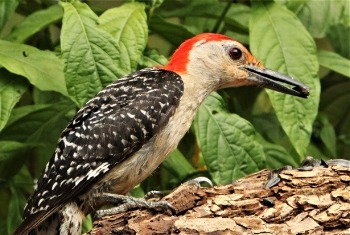
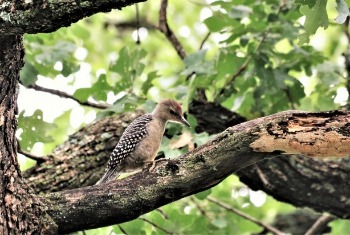
A Red-bellied Woodpecker is often mistaken for a Red-Headed Woodpile, however, the snout is comparatively less dense.
They have a very dark-shaded body which is hard to identify but they possess black and white markings typical of woodpecker backs. Female (second image) Red bellied Woodpeckers lack the red caps that males (first image) have and are only reddish on their sides.
The Red bellied Woodpeckers are common in Eastern states, they don’t migrate.
These birds reside in dead trees for a number of years.
Behavior
These woodpeckers don’t visit backyards and bird feeders. They usually just search for food on tree trunks and perch on their branches.
Diet
The Red bellied Woodpeckers consume insects and spiders from plants, they may also feed nestlings.
They are omnivorous just like most woodpeckers. But during winter, plant material like acorns, nuts, wild and cultivated fruits, and seeds take over their diet.
Fun Fact
These birds are spotted using the cracks in trees to store their food. They come back to these in the next season.
12 . Blue Jay (Cyanocitta cristata)
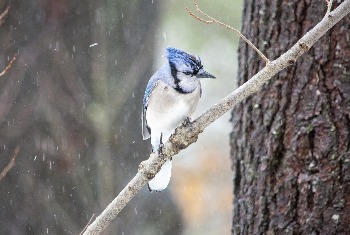
Blue Jays are generally large songbirds with a white underside and an upright blue crest. They have black streaks above their beaks and a single black line from their necks up to their napes.
A blue Jay can roam the entire length of North America and southern Canada. Some birds migrate to the west during winter, but not often. s.
Behavior
These noisy birds love to travel together with their family members.
They are primarily residing in woods close to oak trees full of acorns. They only choose to eat something else when there are no more acorns to be found; they sometimes store acorns in holes in the ground.
They also visit bird feeders with seeds and suet.
Diet
Blue Jays are omnivorous. Most of their diet is vegetable matter, aside from acorns they also take interest in many kinds of nuts and seeds.
Occasionally, they eat insects like caterpillars, beetles, grasshoppers, and some arthropods.
What’s rare is that you may find this bird feeding on small rodents too, surprising right?
Fun Fact
These birds have sexual monomorphism, meaning both male and female birds share the exact same appearance, almost uncanny. While other species have color and pattern differences between genders, Blue Jays only differ in size.
How Many Species Of Birds Does Maryland Host?
With a 350 feet elevation, there are around 456 documented species of birds in Maryland. Not only is this state abundant with species that may be on your birdwatching list, but it also has about 72 rare, threatened, or endangered species!
Roaming Tip: Hold on tight! We’ll swoon by this state in a jiffy — Birds Of Wisconsin.
Watch This!
Part 2:
Frequently Asked Questions
What are the most prominent species in Maryland during the winter?
Wintertime is when most bird species migrate and breed.
This can only mean one thing, winter may not be the best time to visit the state for birding.
However, if you’re favorite birds are the ever-radiant Northern Cardinals, the adorable Carolina Chickadees, the strange singing Mourning Doves, or the striking White-throated sparrows, winter is certainly your season!
That’s because, during the chill of the snow, these three birds are most frequently seen going on about their daily lives and visiting backyards for feeders and bird baths.
How can I identify a bird?
The 4 Keys to Identifying Bird Species by the American Birding Association may help you on your quest.
This states that a bird’s size and shape, colors, patterns, behaviors, and habitats are the 4 things about them that lead to accurate identification.
Birds are sensuous creatures, if you’re an auditory learner, you can listen to their songs and vocalizations to identify them.
But if you’re a visual learner, then their appearance will surely help you out. Listed below are the five parts of a bird that usually sets them apart from other species:
- Throat patch.
- Color of upper and lower beak.
- Color of the lore
- Crown stripe
- Eyering
What Maryland birds nest on the ground?
Having to search for tiny little birds’ nest boxes on tree branches and bushes is surely a hassle.
Luckily in the state of Maryland, the Barn Owl, American Kestrel, Long-Eared Owl, and Northern Harrier nest on the ground, perfect for your birding binoculars!
Conclusion
Now that you know so much about these beautiful birds, it’s your chance to book your next birdwatching trip! Always make sure to carry proper equipment during your birding sessions to ensure your safety.
And in order to ensure the safety of these little birds, remember to keep your distance and never disturb them as they go about their day-to-day lives.
Happy birding!

